Last Updated on September 13, 2023
So you’re interested in joining the ranks of the United States Navy, and you’ve heard about something called a “Navy urinalysis.” What is it, and why is it so integral to naval life?
If you’re aspiring to be an officer or are merely curious, this article will serve as a comprehensive guide to understanding the what, why, and how of the Navy’s urinalysis program.
Understanding the Basics: The What and Why of Navy Urinalysis
Before we dive into the complexities, let’s get a foundational understanding. A Navy urinalysis is a drug test that uses a urine sample to screen for illegal substances. This could be anything from marijuana and cocaine to opioids and hallucinogens.
Prescription medications are usually not tested for, but sailors are warned that certain medications can cause a false positive. It is important to inform the Navy of all medications you’re taking prior to the test.
The purpose of these tests is two-fold: to keep our troops safe and healthy, and to deter drug use among active personnel.
The Navy’s drug policy is clear: “The unlawful use, possession, distribution, sale, manufacture, or cultivation of drugs by Navy personnel is prohibited. This includes the use of drugs while on duty, in uniform, and aboard naval vessels.”
A Brief History
The urinalysis program wasn’t always part and parcel of naval life. The U.S. Department of Defense implemented this screening process across all military branches in the 1980s.
This push came after several incidents highlighted the risks of drug abuse within the ranks (Department of Defense, 1981).
Since then, the Navy has considered the urinalysis program crucial for ensuring the highest level of integrity and fitness among its personnel.
Importance of Navy Urinalysis
You might wonder, “Why so much fuss over a urine test?” Well, the Navy takes this extremely seriously, and here’s why.
Ensuring Fitness and Readiness
In an environment where one wrong move can put lives at risk, there’s no room for substance abuse. A Navy urinalysis is a foundational aspect of a sailor’s physical and mental assessment.
Any sign of drug use could compromise the mission at hand, jeopardizing not only the user but also the entire team.
The culture of the Navy does not tolerate illegal substance use, and a urinalysis is just one of many measures to keep members focused on the job.
Legal and Career Consequences
Let’s talk numbers. If you test positive, you could look at an array of penalties. These range from rank demotion and forfeiture of pay to more severe consequences like court-martial proceedings.
In extreme cases, it could even lead to a dishonorable discharge, which effectively ruins any prospects of a civilian career.
The Navy has a zero tolerance policy for drug use and abuse.
How It Works: The Testing Process
Understanding how the process works can save you from unwanted surprises. Let’s break it down step-by-step.
The Random Element
Selection for a urinalysis is often random, using a computer-generated list, though targeted tests can be administered if there’s reasonable cause to suspect illicit drug use.
There’s an element of unpredictability to deter sailors from substance abuse.
The selection process uses a computer-generated list which is completely randomized, so there is an element of unpredictability to deter sailors from engaging in illegal substance use.
Besides random testing, the Navy may also administer targeted tests if there’s reasonable cause to suspect drug use.
The command sweep urinalysis is a special form of targeted testing. It’s conducted to look for patterns of drug abuse in a particular command or location, and it can be unpredictable.
Collection and Preservation
The Navy follows a stringent protocol to prevent any tampering:
- Preparation: You’ll be given a collection cup and escorted to the restrooms.
- Sample Collection: An observer will be present to ensure the urinalysis sample is yours.
- Sealing and Labeling: The cup is sealed, labeled, and signed off by the observer.
- Transport: Samples are transported to a Naval Drug Screening Lab.
Lab Analysis
Once the sample reaches one of the Navy drug screening laboratories, it goes through a two-tier testing process:
- Initial Immunoassay Screening: This is the first filter that eliminates samples that are negative for any controlled substances.
- Gas Chromatography/Mass Spectrometry (GC/MS): If the immunoassay shows a positive result, this secondary test confirms the presence and type of drug involved.
The Numbers Game: Statistical Overview
In 2019, the Navy reported that about 2.5 percent of urinalysis tests came back positive for illicit substances (Navy Personnel Command, 2019).
Though the percentage might appear low, the consequences for those who fall into this category are far from minor.
Real-Life Scenarios: Case Studies
An understanding of case studies can be enlightening.
A Derailed Career
One ensign who had recently graduated from the Naval Academy tested positive for cocaine. The result was a court-martial and a dishonorable discharge, putting an abrupt end to what could have been a promising career.
The Saving Grace of GC/MS
On the flip side, another officer’s initial screening falsely identified a prescription medication as an illicit substance. Thanks to the GC/MS secondary test, the officer was cleared of all charges.
Busting Myths About Navy Urinalysis
Misinformation can lead to unnecessary panic or careless decisions. Let’s debunk a few common myths:
Myth 1: Tests are Easy to Cheat
Fact: Sophisticated detection methods and a rigorous chain-of-custody make cheating virtually impossible.
Myth 2: Prescription Drugs will Get You into Trouble
Fact: As long as you disclose any prescriptions to your superiors and medical personnel, these substances can be accounted for in the testing process.
Myth 3: False Positives Are Common
Fact: While initial screenings may sometimes produce false positives, the secondary GC/MS test minimizes this risk.
Wrap-Up
By now, you should have an in-depth understanding of what a Navy urinalysis is, why it’s important, and how it’s conducted.
It is a pivotal part of maintaining the Navy’s strict standards of discipline, fitness, and readiness. So if you’re planning a career as a Navy officer, remember: staying clean isn’t just a rule—it’s a core value that reflects your commitment to service.


